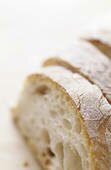 It seems that people who share the name Reinhart (or Reinhardt, in my case) are an obsessive bunch. My obsession is all things beer and fermentation, and Peter Reinhart’s is bread.
It seems that people who share the name Reinhart (or Reinhardt, in my case) are an obsessive bunch. My obsession is all things beer and fermentation, and Peter Reinhart’s is bread.
I purchased The Break Baker’s Apprentice for my wife over Christmas and was glad that she wanted it as a gift so I didn’t get stuck in the proverbial “you bought me an iron” or “you bought this for yourself” type gift. Truth be told, I won’t begrudge the claim that I wanted this book for myself as well as offering it as a present to my spouse.
The above being said, I dove into this book with a notable celerity and fervor. Now that I’ve been combing the volume and making some (even better) homemade bread, I feel compelled to offer my thoughts on the book.
Do you make your own bread? Do you want to? Do you want to understand the how and why behind making really good bread? Look no further. This book is terrific and I highly recommend that you purchase it. Following is my take on what you should expect as a buyer of The Bread Baker’s Apprentice: Mastering the Art of Extraordinary Bread:
Bread as Science and Art:
Too often, art and science are spoken of in mutually exclusive terms. And while it is true that dichotomies exist in many respects, culinary process is a happy marriage of art and science. The name “Artisan,” when speaking about making unique and tasty breads, is apt nomenclature. So, expect to see some formulas for making great bread but also expect that tactile nature and experience of bread making to be emphatic in this book. ”Know thy bread by touch” might be an accurate characterization of how Peter Reinhart sees bread making.
But make no mistake, process is an important aspect of this book as well. I won’t belabor the point too far by listing them out, but the book walks through the twelve stages—yes, I said twelve—of making bread. It also emphasizes the important of temps, timing, and waiting. Reinhart makes arguments for natural sugars in bread (via flour) being the source of fermentation and flavors (a bit of a head trip for those of us who “proof” our yeast with some 105-115 water with some sugar before mixing).
Instead, he offers methods of fermentation, including cold, that tease out the complexities of flour and creates fantastic results. I read about cold fermentation awhile back via Jeff Varisano’s great pizza crust technic, but Rinehart’s book filled out the ideas.
Reinhart spares no science when he speaks about the role of enzymes and amylase (terms I’m familiar with due to my brewing experience) in making a great loaf of bread. However, the concepts and language aren’t inaccessible and unwieldy for those who want to perform a little “food for thought.” Ultimately, the explanations he gives offer the science and reasons behind the tasks undertaken while making bread. Who wants to perform rote activities without knowing why?…even the most pragmatic person couldn’t turn away from Reinhart’s discussions.
In the end, the reader will not only begin to grasp what is happening during the bread process, he or she is encouraged, based on their newly found skill sets, to explore and be an artist. Put your touch and your signature on any bread you want.
The Tradition of Gastronomy:
Speaking of unique breads and creating bread on your own. The book spends time speaking a bit about those ever iconoclastic Americans and their penchant for exploration. Reinhart notes that one of the reasons American bread makers are making great new loaves, as well as traditional ones, in unexpected ways, is lack of rigid tradition (i.e., we just, unlike some French bread makers, love to explore and play…an easy matter without some of the more hard and fast expectations).
Bread and Humans
Bread is as old as civilization itself. Bread is a past time. Bread is a staple of life. If I had to pick a reason I think Reinhart is so passionate about bread and teaching us how to make it, I think I would say that he believes it is intimately human. Bread is simultaneously ridiculously simple and absurdly complex. It is one of the simplest and greatest pleasures of life. The above, at least in my estimation, is the real point of The Bread Baker’s Apprentice, namely, a passionate prose that is meant to re-discover the pleasure of a good loaf made by the hands of person eating it.
Concluding Thoughts:
Peter Reinhart alludes to the meaning and asthetics of bread making by asking us to consider the response that even an ordinary homemade loaf of gets in comparison a store bought one. He insists on his students not calling the loaves of bread products. Apart from the inherent critic on our ever industrial process of food making, he simply loves seeing bread making as a learning and teaching journey that builds in us something we might not otherwise have known.
This is a great and inspiring book. Give it a read.
